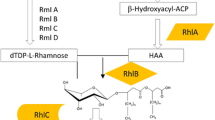Abstract
Pseudomonas aeruginosa produces and secretes rhamnose-containing glycolipid biosurfactants called rhamnolipids. This review describes rhamnolipid biosynthesis and potential industrial and environmental applications of rhamnolipids. Rhamnolipid production is dependent on central metabolic pathways, such as fatty acid synthesis and dTDP-activated sugars, as well as on enzymes participating in the production of the exopolysaccharide alginate. Synthesis of these surfactants is regulated by a very complex genetic regulatory system that also controls different P. aeruginosa virulence-associated traits. Rhamnolipids have several potential industrial and environmental applications including the production of fine chemicals, the characterization of surfaces and surface coatings, as additives for environmental remediation, and as a biological control agent. Realization of this wide variety of applications requires economical commercial-scale production of rhamnolipids.
Similar content being viewed by others
Author information
Authors and Affiliations
Additional information
Received: 4 February 2000 / Received revision: 9 June 2000 / Accepted: 9 June 2000
Rights and permissions
About this article
Cite this article
Maier, R., Soberón-Chávez, G. Pseudomonas aeruginosa rhamnolipids: biosynthesis and potential applications. Appl Microbiol Biotechnol 54, 625–633 (2000). https://doi.org/10.1007/s002530000443
Issue Date:
DOI: https://doi.org/10.1007/s002530000443




